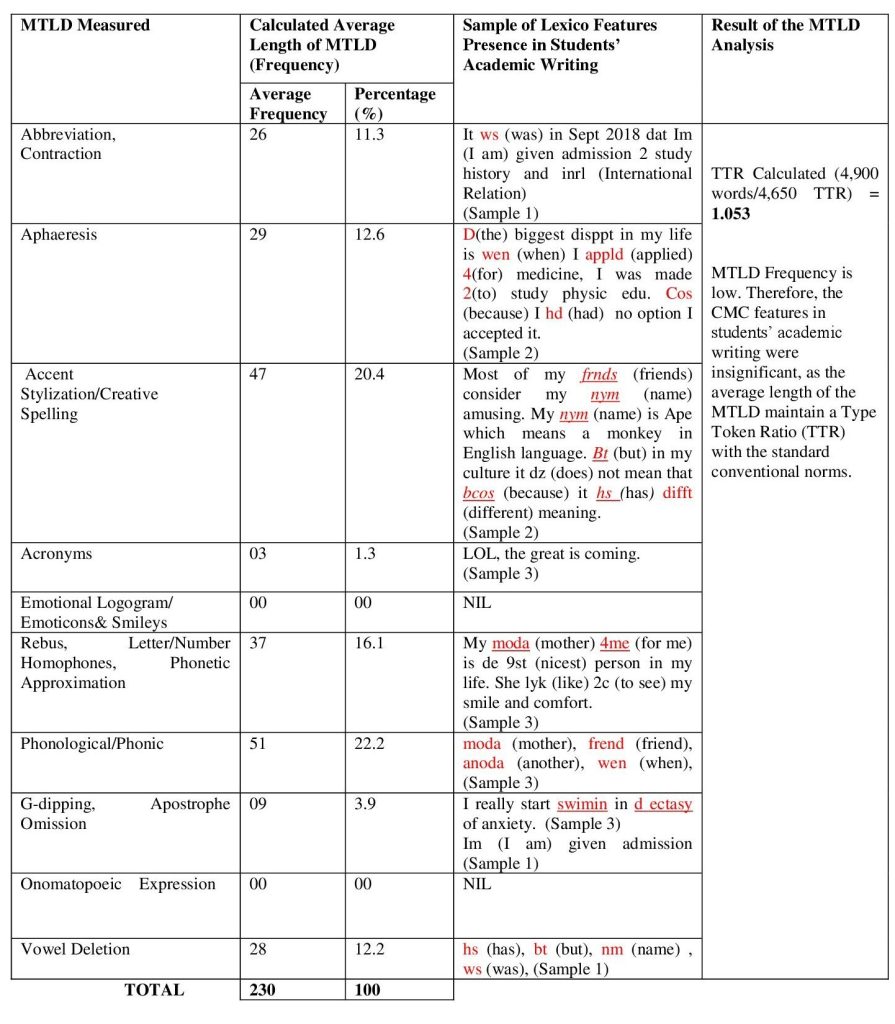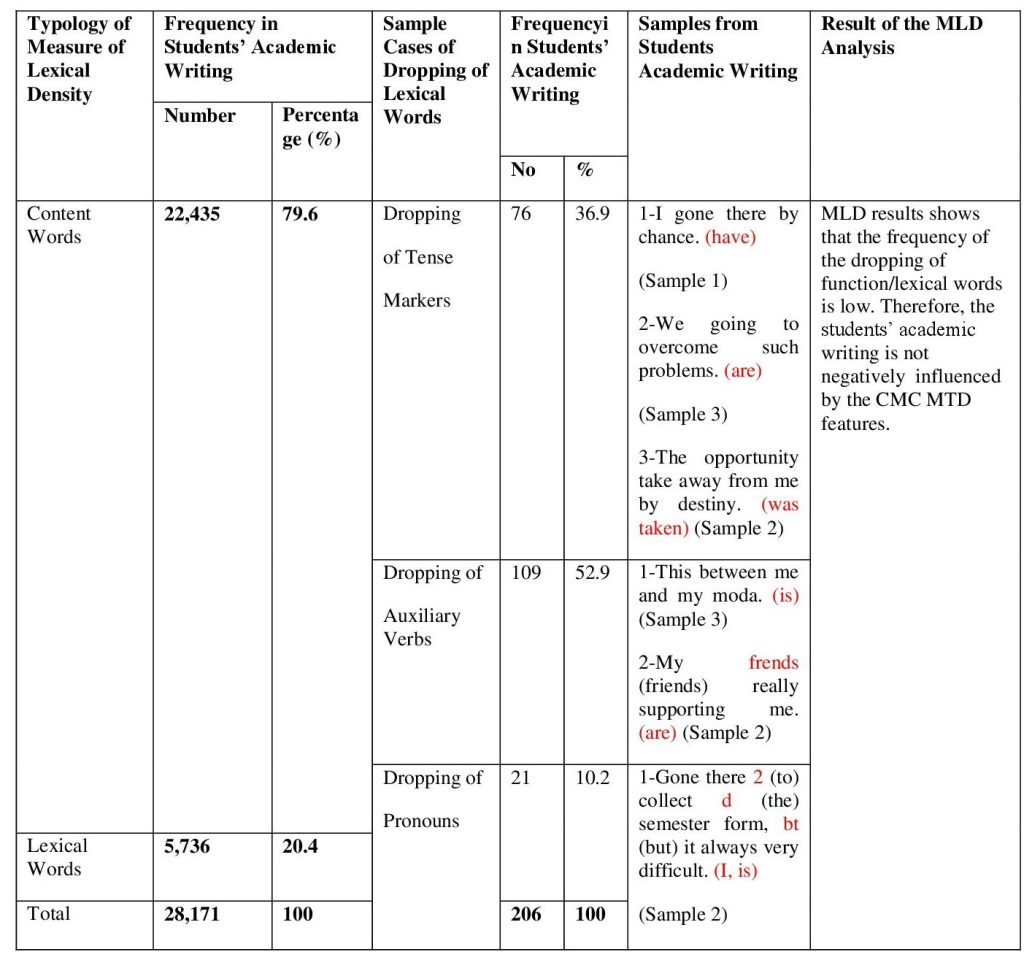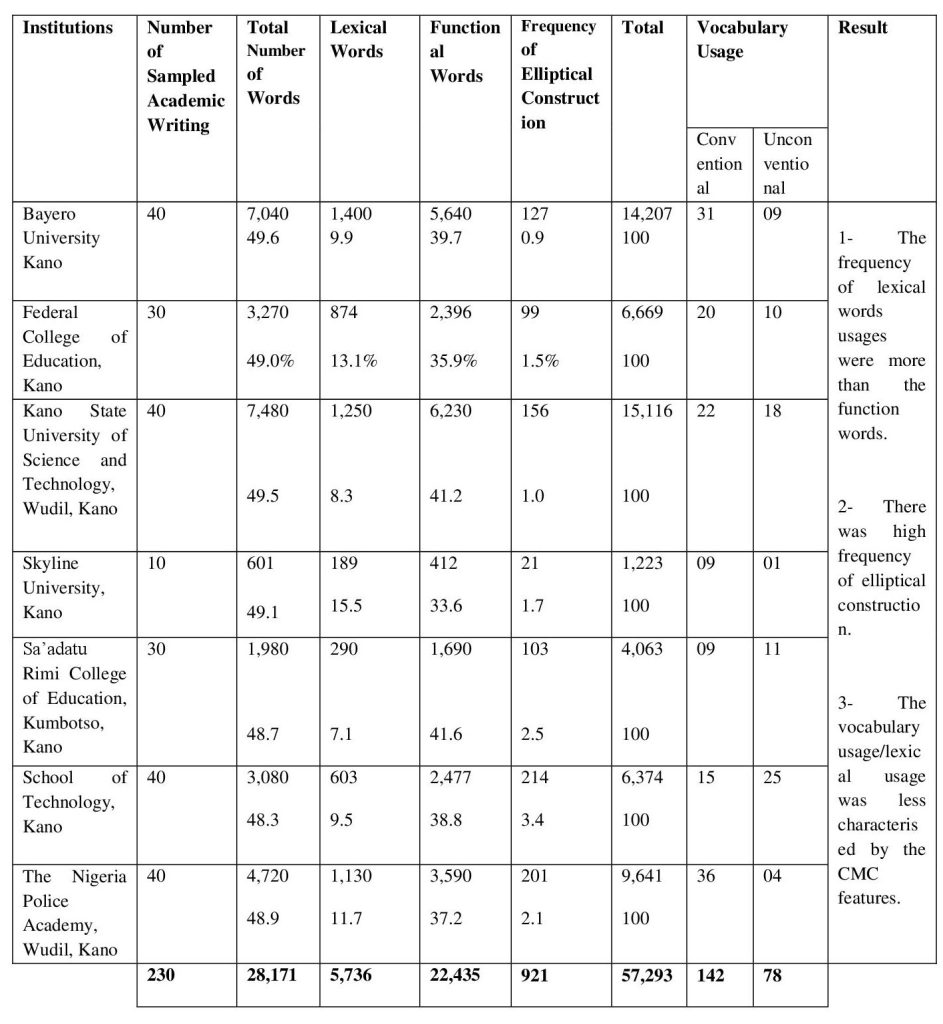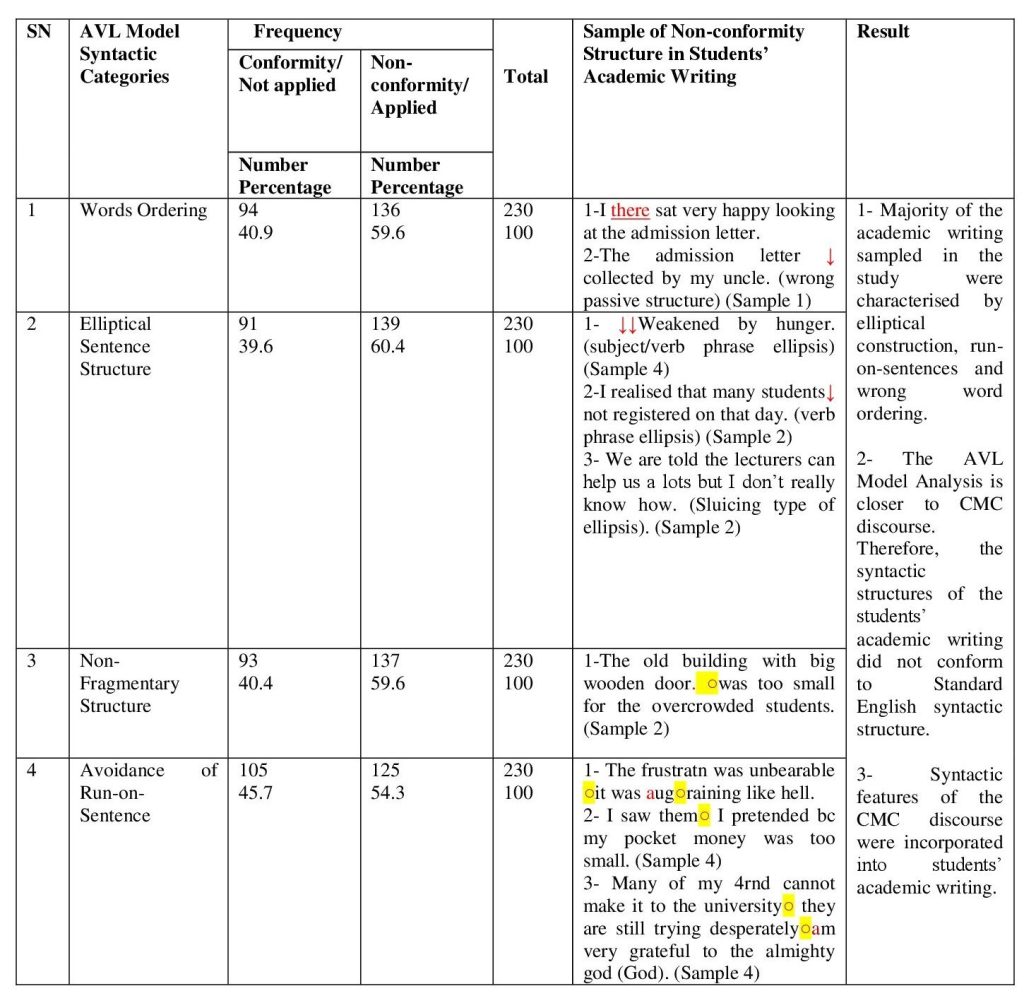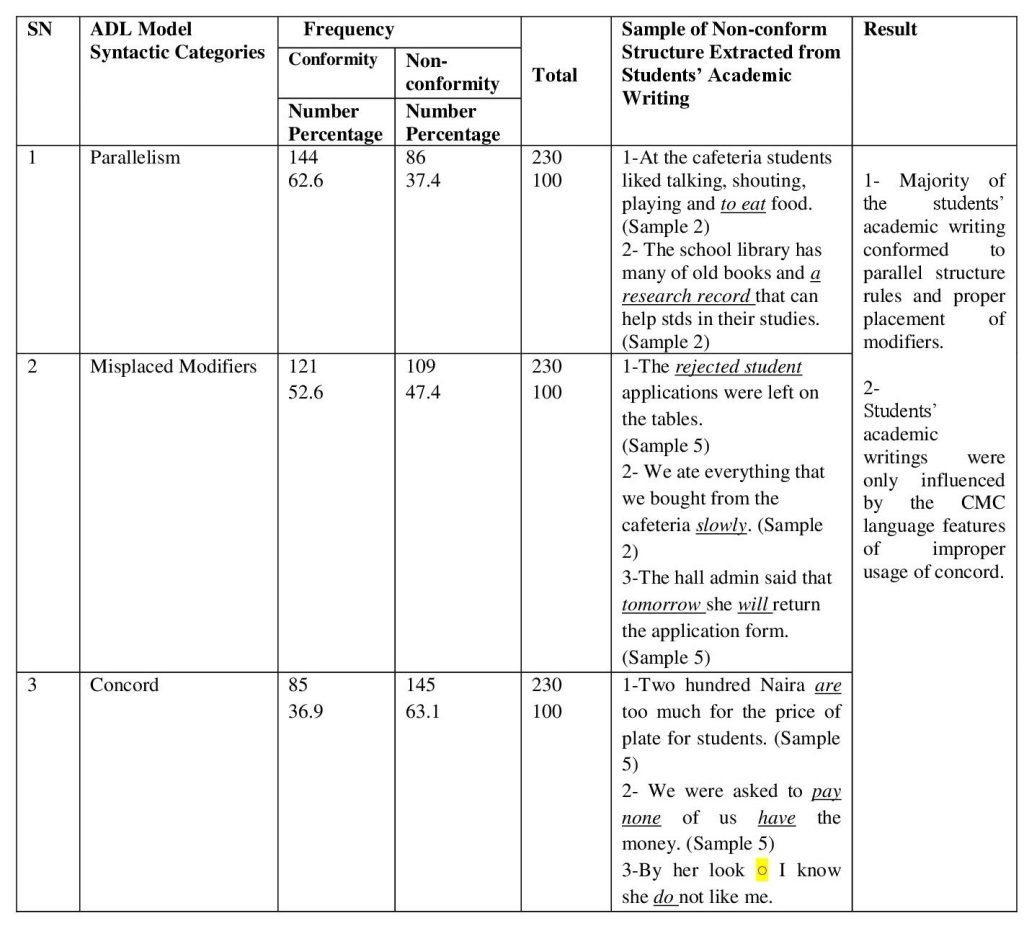|
International Journal of General Studies (IJGS), Vol. 2, No. 3, October-December 2022, https://klamidas.com/ijgs-v2n3-2022-04/ |
||
|
A Lexico-Syntactic Analysis of the Impact of Computer Mediated Communication on the Academic Writing of Students of Tertiary Institutions in Kano State By Mudassir Hassan & Balkisu Sanusi* Abstract The unprecedented upsurge in ICT technology which uniquely characterised the 21st century is predominantly influential on the conventional traditional orthography. The development has precipitated the emergence of Computer Mediated Discourse (CMD). Conversely, it differs from the conventional orthography that is traditionally accepted in the context of academic writing. Indeed, language teachers complain of the indiscriminate transfer of the CMD features; lexical and syntactic features in students’ academic writing. This, they believe, negates students ability to write excellent and conventionally-based academic discourse. This study explores the lexico-syntactic impact of CMD features on the academic writing skills of the students of tertiary institutions in Kano State. The study examines how CMD associated lexical and syntactic features are transferred in the context of students’ academic writing. There were 230 participants (students of tertiary institutions in Kano State) in the study who were selected through Purposive Sampling Technique. Data for the study was collected through observatory technique; as samples of students academic writing were collected for observatory analysis. Verheijen (2016) and McCarthy & Jarvis (2010) Model of lexico-syntactic Analysis was used in analysing collected samples of students’ academic writing. Findings of the study revealed that CMD lexico-syntactic features had minimal/insignificant impact on the academic writing proficiency of the students of tertiary institutions in Kano State. Keywords: ICT, Computer Mediated Discourse (CMD), lexico-syntactic, Kano State Introduction The emergence of what Crystal (2001) describes as ‘Netspeak’, ‘Computer-Mediated Communication’ or ‘Cyber-Slang’, which is a computer/digital based discourse akin to the 19th Century old technology of telegraph has attracted attention and criticisms from scholars and researchers the world over (Hassan, 2010). Some of the scholars and researchers observe that the new digital based discourse is a potential threat to language standard, as it is capable of rendering convention in language obsolete. This pessimistic view is precipitated by the indiscriminate application of the linguistic features of the Computer-Mediated Communication (CMC) in the academic context by students at the various levels of learning. The aim of lexico-syntactic impact analysis of CMC on the students’ academic writing is to investigate the degree of transfer or incorporation of those lexical categories such as the use of informal abbreviation, wrong use of punctuations, as well as the application of invented orthographical forms. In addition, the syntactic analysis is done through seven syntactic categories of words ordering, ellipsis, full sentence, run-on-sentence, parallelism, modifier placement and concords. The focus of the analysis is to measure the frequencies of those lexical and syntactic categories associated with CMC discourse that are present or incorporated in the context of students’ academic writing. Aim and Objectives of the Study The primary aim of the study is to examine how the associated lexical and syntactic features of the synchronous and asynchronous CMC discourse influence the academic writing of the selected students of tertiary institutions in Kano State, Nigeria. Specifically, the objectives set to guide the study are to:
The study analyses data from two primary sources: samples of students’ academic writing; assignments, test, exam scripts, corpus of students’ CMCs and the use of questionnaire. The study also adopts the methodology framework used by scholars in CMC discourse (Ivanov, 2012; Herring, 2008). The collected data for the study is analysed based on the model developed by Verheijen (2016) and McCarthy & Jarvis (2010) for the purpose of analysing the lexico-syntactic impact of the CMC discourse on the academic writing/discourse. The model proposes two levels of CMC analysis; lexical and syntactic. The lexical analysis is conducted at three different levels:
At the level of the syntactic, the procedure for analysing the syntactic impact of the CMC discourse on the academic writing is conducted on seven identified levels/categories as proposed in the model adopted for analysis: words ordering (syntactic arrangement), ellipsis, full sentence, run-on- sentence, parallelism, modifier placement and concord. Method of Data Analysis The data analysis in this study is carried out in four parts and the Lexico-syntactic parts is based on the Verheijen (2016) and McCarthy & Jarvis (2010) model. Part one analyses the data in terms of the CMC lexical features that are transferred or incorporated in the context of students academic writing. The lexical features include the application of informal orthography, abbreviations, se of speech-like form of writing, vocabulary usages and dropping of punctuations. In part two of the analysis, the syntactic features are analysed based on six identified categories (word ordering, ellipsis, full sentence, run-on- sentence, parallelism, modifier placement, concord). The part three and four of the analysis are not based on the Verheijen (2016) and McCarthy & Jarvis (2010) model. Data Presentation and Analysis CMC Lexical Features in Selected Students Academic Writing Data for the analysis is collected through the examination of the selected samples of students academic writing and analysed based on the Verheijen (2016) and McCarthy & Jarvis (2010) model for analysing the CMC Lexical features in academic writing context. The analysis is presented in tabular forms: Table 1: Measure of Textual Lexical Density (MTLD)
Table 1 shows a typology of the CMC language features in students’ academic writing including their corresponding occurrence/frequency, as well as the accompanying examples of such features from the students’ academic writing (samples). The CMC language features and their frequency are at different level of occurrence; phonic features 22.2% (eg moda for mother; frend for friend) accent stylization or creative spelling 20.4% (eg nym for name; bt for but), phonetic approximation 16.1% (eg, 9st for nicest; 2c for to see) Aphaeresis 12.6% (eg d for the ; 2 for two), acronyms, abbreviation and contraction was 11.3% (eg inrl for International Relation, im for I am) , G-dipping 3.9% (eg swimin for swimming) and acronyms 1.3% (eg LOL). This means that Phonic features and accent stylization are the most frequently used, while G-dipping and acronyms are infrequent in students’ academic writings. The two categories of onomatopoeic expressions and emoticons are not detected in students’ academic writings. Overall, the MTLD features show lower lexical diversity, while CMC features show higher lexical diversity; as such the students’ academic writings are not heavily characterised by those informal lexical features of the CMC. Measure of Lexical Density (MLD) The second level of lexical analysis is the Measure of Lexical Density (MLD). The focus of the analysis is to identify the frequency of the appropriate application of content words (Opened-Class Grammatical Items). The analysis is based on the perceived assumption that CMC discourse is characterised by the use of content words to communicate, while function words are deliberately dropped. The MLD analysis is presented in tabular form: Table 2: MLD Analysis of CMC Features in Students’ Academic Writing
The analysis presented in Table 2 shows that the frequencies and percentage of contents words in the students’ academic writing is 22,435 (79.6%) respectively, while the lexical items are 5,736 (20.4%). This indicates that the lexical items usage is lower than the content words usage. For example, few lexical words like auxiliary verbs (is, are), pronouns ( I )and tense markers ( have, are, was) are dropped. Similarly, the frequency in the dropping of tense markers is 36.9%, auxiliary verbs (52.9%) and pronouns (10.2%). This indicates that auxiliary verbs dropping is the highest (52.9%) followed by tense markers (36.9%). Pronoun dropping as in the case of dropping the subject of the sentence ‘I’ in Sample 2 of the sample, is the least (10.2%). Overall, the MLD results indicate that the students’ academic writing is not highly characterised by the awkward dropping or deletion of some lexical items in sentence construction. Therefore, students’ academic writing is not predominantly characterised by the CMC language feature of deletion or deliberate dropping of some lexical items in sentence construction/structure. Measure of Density of Elliptical Construction (DEC) This level of analysis is used for the identification of the number/frequency of vocabulary items (presence of functional and lexical words), as well the frequency of the omission of punctuations in students’ academic writing. The frequencies of the occurrence of functional and lexical items, as well as omission of punctuation marks determine the closeness of the writing to CMC. Table 3: Density of Elliptical Constructions in Students’ Sampled Academic Writing
Table 3 indicates that the frequency of function words in students’ academic writing is more than the frequency of the function words. The vocabulary usage is not characterised by the application of idiolect and created words. Similarly, the vocabulary is not dominated by the use of words typically associated with the members of CMC communities. The word usage in the students’ writing are based on the conventional and standard format that is typically accepted in the academic context. For examples, there is less dropping of functional words and there is less usage of self-created words. Therefore, the vocabulary usage in sample essays are less characterised by CMC language features; as such there is no significant impact of CMC discourse on students’ academic writing proficiency. Table 4: Omission of Punctuations in Students Academic Writing
Table 4 indicates the frequency in the omission of punctuation marks that characterise the students’ academic writing. The analysis reveals that majority of the students’ academic writings (99.1%) are characterised by the omission of punctuation, while only 0.9% are not. This means that the students’ writings do not comply with one of the basic requirements of the academic writing skills of mechanical accuracy. Most of the non-compliance cases of the proper application of punctuations include non-insertion of full stop, when words are abbreviated (eg in the abbreviation of the Proper Noun, August, it is abbreviated as ‘aug’; ‘std’) . Many cases of abbreviations without full stop ( eg ‘aug’; were detected in the samples that were analysed in the study. Syntactic Level Analysis The Syntactic Analysis is used to examine students’ academic writing in relation to sentence structure such as the conformity of the sentences to SVO structure, as well as the closeness of the subject of the sentence to other grammatical elements in sentences. The syntactic level of the model of analysis is conducted at levels; Analysis of the Average Length Model (AVL), which measures or analyses the conformity of students’ academic writing to word ordering, elliptical sentence construction, run-on- sentences and sentence fragment) and Analysis of Dependency Length (ADL), which measures or analyses parallel structure and concord. The two levels provide a framework for analysing the conformity of the sentence use by students in their academic discourse to conventional sentence structure of the English sentences. Table 5: The AVL of CMC on Students’ Academic Writing
The analysis in Table 5 reveals that CMC language features (syntactic) are detected in the majority of the sample academic writing as 59.6% of the writing do not conform to the standard placement of words of the English language; adverbs, adjectives and prepositions are wrongly placed, as in “I there sat very happy looking at the admission letter” where adverb is wrongly placed. Similarly, auxiliary verbs in passive form construction are omitted, as shown in this sample, “The admission letter collected by my uncle”. In respect to word order relating to sentence patterns, majority of the sentences in students writing display the conventional SVO patterns. However, not all sentences conform to subject-verb agreement (SVA pattern) structure. As regards elliptical sentence structure, many detected sentences are elliptical (60.4%); as there are many instances of dropping of subjects and verb in passive verb structure; for examples, “Weakened by hunger”. Similarly, 59.6% of the sample academic writings (students) are characterised by fragmentary sentence structures as in “The old building with big wooden door. was too small for the overcrowded students”. In addition, it is revealed that 54.3% run-on-sentences are detected; for examples, “Many of my 4rnd cannot make it to the university they are still trying desperately am very grateful to the almighty god”. The high frequency of the presence of fragmentary and run-on-sentences reveals that majority of the students’ academic writings are characterised by the incorporation of those syntactic language features of the CMC. Table 6: The ADL of CMC on Students’ Academic Writing
The analysis in Table 6 reveals that majority of the students’ academic writing is not characterised by the non-conformity of parallel structure (parallelism) as 62.6% of the sentences did conform to the conventional parallel structure of the Standard English, while 37.4% deviates from the standard norms. Examples of the deviated structures with non-parallel construction are “At the cafeteria students liked talking, shouting, playing and to eat food” and “The school library has many of old books and a research record that can help stds in their studies”. This means that the high frequency of the conformity to the standard norms indicates closeness of the students’ writing to academic writing style and less characterised by the CMC language features. Similarly, it is an obvious indication that the use of unparallel sentence structure that characterised the CMC sentences is less incorporated in the context of sampled students’ academic writing. Therefore, students’ academic writing is not predominantly characterised by the CMC language feature of unparallel sentence structure. The frequency of the conformity of proper placement of modifiers (adjectives and adverbs) was 52.6% while that of non-conformity was 47.4% as in The hall admin said that tomorrow she will return the application form. This means that majority of the students’ academic writing conform to the grammatical rules of proper placement of modifiers. However, the analysis reveals that majority of the sample students’ academic writings do not conform to concord rules as only 36.9% of the sample writings conformed to the conventional rules of concord, while majority, 63.1% did not conform (eg Two hundred Naira are too much for the price of plate for students). The high frequency of the non-conformity indicates that students’ academic writings are characterised by the CMC syntactic features of non-conformity to the conventional rules of concord. Discussion on Findings The lexical processes that serve as units of analysis made through the categories of contractions; shortenings and abbreviations; initialisms and alphabetisms; aphaeresis; phonetic approximations; G-clippings; rebus, letter and number or number and letter homophones; accent stylisations and respellings; misspellings, punctuations, logographs and emoticons; self-created acronyms and words and deliberate dropping of sentence parts. The focus of the analysis is to examine the frequency or degree of the application of the CMC lexical categories in the students’ academic writings. The study reveals that some lexical categories have impact on the students’ academic writing. This is determined by their incorporation and high level of occurrence in the sampled students’ academic writing. The lexical categories that have negative impact on the students’ academic writings are misspelling and non-application of punctuations as detected in sampled students’ academic writing; nym, wen, moda, frend; aug, I was scared bt cannot do anything. Students misused these two categories. However, other lexical categories of abbreviation, and vocabulary usages are used in conformity with the conventional norms; that is in accordance with the standard English rules. Therefore, it is obvious that the students’ academic writings at the tertiary level in Kano State is less characterised by the indiscriminate application of the CMC informal language features. Consequently, students’ academic writing is generally closer to standard conventional norms. Emoticons and Onomatopoeic expressions are not used at all in the students’ academic writing. This is another indication of the closeness and conformity of the students’ academic writing to standard usage; as the two categories are parts of the essential distinguishing features of CMC discourse. At the syntactic level, all the syntactic structures of word order (SVO); full sentences; sentence fragments; run-on sentences; subject-verb agreement (SVA); misplaced modifiers, paralleled structure and elliptical construction are analysed in terms of whether they conform to, or deviate from, Standard English syntactic structures. Findings of the study reveal that students’ maintain effective use of word order, full sentence construction and parallel structure. However, irregular elliptical construction (eg I realised that many students↓ not registered on that day.) misplaced modifiers (eg The hall admin said that tomorrow she will return the application) and concord (eg By her look I know she do not like me.) are detected in students’ academic writing. Though, it can be argued that the wrong usages of these categories are parts of the typical and commonly manifested language deficiency problem of the Second Language Learners, especially in the Nigerian context. However, it is evident from the data analysis of students’ academic writings that the detected problems reflect CMC-like language features. Therefore, it can be argued that they are not similar to commonly associated problems found in students writing as a result of the poor mastery of the English language. In addition, the grammatical features and the sentence types detected in sample essays display the conventional English subject-verb-object (SVO) word order, and few of them omitted subject pronouns, possessive pronouns, or prepositions. However, omission of a verb to be form and auxiliary verbs, especially in passive form and indirect speeches are detected. It is also established by the findings of the study that the lexical and syntactic features in students’ academic writing are not the same with that of the CMC discourse. This is revealed by the infrequent transfer of the CMC linguistic features in students’ academic writing. Therefore, the level of influence or impact of the CMC discourse on the students’ writing proficiency is significantly low. It is also revealed by the findings of the study that there are high frequencies in the applications of standard words ordering and full sentence structure in the students’ academic writing. This means that the syntactic category of words ordering in the students’ academic writings conform to the standard conventional norms. However, there are high frequencies or presence of misplaced modifiers, use of informal abbreviations, spellings, improper use of punctuation, run-on-sentence and application of fragmentary structures. The high frequencies of these categories indicate the influence of the CMC in the students’ academic writings. In addition, there are low frequencies of parallel structure, concord and application of informal vocabulary or self-created words. Therefore, the analysis reveals that some CMC Lexico-syntactic categories have influence on the students’ academic writings, while others do not. Overall, the level of influence is minimal. Conclusion Findings of the study reveal that lexical categories peculiar to CMC discourse do not impact significantly on the academic writing of students of tertiary institutions in Kano State. Except that, the lexical categories of poor spelling and wrong use of punctuation have negative impact on students academic writing skills. On the other hand, the syntactic categories of run-on-sentences, fragmentary structures have negative impact on students academic writing, while other syntactic categories do not. Based on the findings of the study, it is indicated that teachers of English language are not proactive in discouraging students’ reckless transfer of the CMC Lexico-syntactic features in the context of academic writing. This is demonstrated in teachers refusal to underlined such abnormal usages and provide comment on the students’ script on the danger of using such informal features in the context of academic writing. It is equally indicated that students consciousness of being members of a formal discourse community is not vibrant. In addition, it is obvious that students’ lack of proficiency in academic writing skill is not determined or precipitated by CMC discourse; as most of the problems that characterised students’ writing are not different from those associated with L2 learners of English language. Therefore, students inefficiencies are attributed by other factors. References Crystal, D. (2001). Language and the Internet. New York: Cambridge University Press. Fairclough, N. (1992). Discourse and Social Change. London: Polity Press. Hassan, M. (2010). Linguistic Creativity in Mobile Phone Short Messaging Service. Unpublished M.A. Thesis, Department of English, Bayero University, Kano Herring, S. C. (2004). Computer-mediated discourse analysis: An approach to researching online behavior. In S. A. Barab, R. Kling, & J. Gray (Eds.), Designing for virtual communities in the service of learning (pp. 338-376). Cambridge/New York: Cambridge University Press. ———– (2008) Language and the Internet. In Donsbatch (Ed.), International Encyclopedia of Communication (pp. 2640-2645). Blackwell Publishers ———– (2010). Digital Media in P. Hogan (Ed.), The Cambridge Encyclopaedia of the Language Sciences. Cambridge: Cambridge University Press ———- & Virtanen, T. (2013). Handbook of Pragmatics of Computer-Mediated Communication. Berlin: Mouton. Ivanov, V. (2012) Heteroglossia. In: Duranti, Alessandro (ed.) Key Terms in Language and Culture, 95-7. Malden, MA: Blackwell. McCarthy, P. & Jarvis, S. (2010). MTL, vocd-D and HD Lexical diversity assessment. Behaviour Research Method, 42 (2), 381-392. Mphahlele, M.&Kwena M. (2005) “The Impact of Short Message Service (SMS) Language on Language Proficiency of Learners and the SMS Dictionaries: A Challenge for Educators and Lexicographers.” IADIS International Conference on Mobile Learning. Sotillo, S. M. (2000). Discourse functions and syntactic complexity in synchronous and asynchronous communication. Language and Learning Technology. 4(1):82-119 Swales, J. M. and Feak, C. B. (2012). Academic Writing for Graduate Students: Essential Tasks and Skills (3rd ed). Michigan: Michigan University Press. Thurlow, C. (2002). Generation TXT? The Sociolinguistics of Text Message, Retrieved from http://faculty Washington.edu/thurlow/ research/papers/thurlow&brown(2003).httm Verheijin, L. (2016). The effect of Text Messaging and Instant Messaging on Literacy, Journal of English Studies, 94(5):582-602 *About the Authors: Dr. Mudassir Hassan (mudakano1973@gmail.com) is a lecturer, Department of English, Nigeria Police Academy, Wudil-Kano; Hajiya Balkisu Sanusi is a lecturer, Department of English, Waziri Umaru Federal Polytechnic, Birnin Kebbi, Kebbi State, Nigeria. |
||

